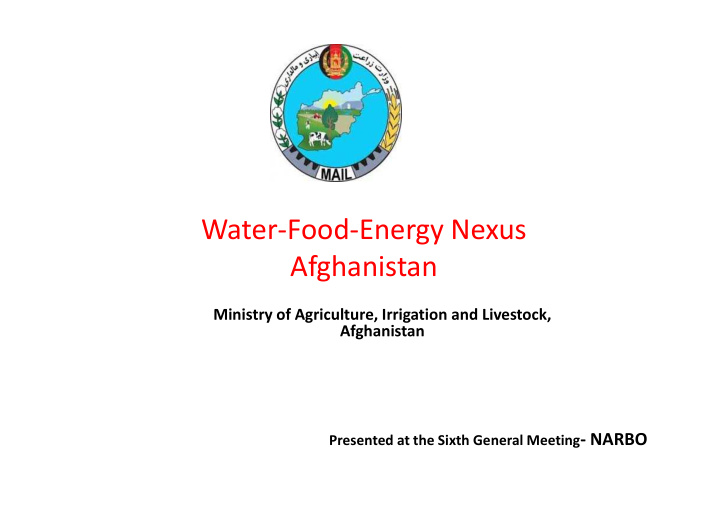



Water-Food-Energy Nexus Afghanistan Afghanistan Ministry of Agriculture, Irrigation and Livestock, Afghanistan Presented at the Sixth General Meeting - NARBO
Introduction • Severe water scarcity in most areas, due to temporal and spatial variability; • Climate change causing low production in rainfed-ag areas; • Low land productivity; • Low land productivity; • 88% covered by mountains, difficulty in access; • Having high potential of energy production but still importing; and • 47% population living below poverty line.
Water-Food • 90-95% of total water used for food production; • 2.1 M-ha of irrigated agriculture; • 1.2 M-ha of wheat area (main food); • 4.5-5.5 M-Ton of wheat production, 1-2 M-ton • 4.5-5.5 M-Ton of wheat production, 1-2 M-ton annual deficit; • Annual 400 M-US$ agriculture export; • Annual 2-3 Billion-US$ agriculture import; • Droughts and Floods; and • Climate Change.
Water-Energy • Potential of producing 23,000 MW of hydor- energy; • Producing less than 500 MW; • Existing basic demand: more than 4,000 MW; • Existing basic demand: more than 4,000 MW; • Energy Import accounts for 77% of demand: – Iran (22%) under 1 contract – Tajikistan ( 4%) under 2 contracts – Turkmenistan (16%) under 2 contracts – Uzbekistan(57%) under 1 contract.
Water-Food-Energy
Water-Food-Energy • Lift irrigation is immense need of Afg-Ag Sector, but due high rates of energy in the country not implemented easily; • High Efficiency Irrigation Systems in most • High Efficiency Irrigation Systems in most cases need energy; • Ag-products processing and value chains strongly linked with energy; and • Mechanized farming directly linked with energy.
Recommendation • W-F-E Interactions are vital and interdependent; • Importance of the nexus is not recognized from a planning and management from a planning and management perspective; • There is an urgent need for a “Nexus Approach” for integration of management and governance across the three sectors; and • Policy alignments.
Questions and Comments
Recommend
More recommend